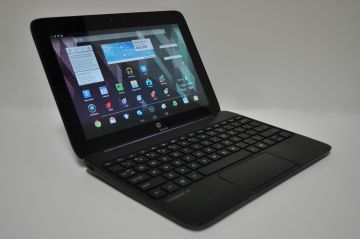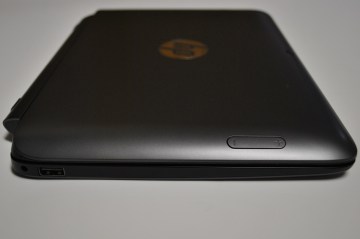I’ve been using HP’s Slatebook X2 on-and-off for nearly two months now. With so many Windows 8 tablets flooding the market this fall, I wanted to see how Android performed on a tablet that doubles as a small laptop.
The Slatebook X2 is a $480 tablet with a 10-inch, 1080p display, an Nvidia Tegra 4 processor, 16 GB of storage and 2 GB of RAM. It’s thin and light enough as a tablet–however plasticky–and performance feels quick for a mobile device.
But what really sets the Slatebook X2 apart is its keyboard and trackpad dock, which is included in that sub-$500 price tag. (Asus led the way with its Transformer tablets, but always sold the dock separately.) Snap the tablet in, and you have a 2.77-pound laptop with its own full-sized SD card slot, USB port and HDMI output. The dock also houses a secondary battery, which adds some necessary weight to the base while providing a few extra hours of juice. It was enough to last me through a nine-hour work day.

Going in, I already had some reservations. Although Android does support mouse input and keyboard shortcuts, the operating system wasn’t really designed with laptops in mind. A couple examples of why were known to me even before using the Slatebook: There’s no windowing system or taskbar for quickly switching between programs, and no right-click functionality within Android apps.
After spending one full work day and many more shorter sessions with the Slatebook X2, I can’t say I’ve really enjoyed doing work on this device. Most of my gripes are not HP’s fault, but are quibbles with Android itself, and they add up to a painful experience when you’re trying to get work done. Here’s a short list of grievances:
- I do a lot of work in Chrome on my desktop PC–especially with WordPress blogging tools–but the Android version of Chrome is no substitute. Bookmarks are harder to reach, and there’s no built-in PDF viewer. Too many pages default to their mobile-optimized versions, and Chrome doesn’t provide a way to always load desktop versions instead. Worst of all is the way your open tabs disappear from view as you scroll down the page, forcing you to scroll back up a little bit to access them again. Switching between tabs in Chrome feels like work on Android tablets.
- Inconsistency runs throughout the system with mouse and keyboard controls. In some apps, double-clicking on a word highlights the text. In others such as Gmail and Chrome, the same action zooms in. Some apps don’t let you select text at all, and not all apps honor important keyboard shortcuts, like Ctrl-Z to undo. (I’m looking at you, Google Keep.)
- Text selection is a chore despite the trackpad. You can’t click and drag to select text like you would on a regular laptop. Instead you must either double-click or click and hold until the text selection markers appear, then click and drag on the actual markers. It’s no better than using your fingers. Many applications don’t let you drag the selector beyond the bottom of the screen, so I struggled to copy and paste large segments of text.
- On some occasions I ran into unpredictable cursor behavior. For instance, while scrolling up or down a page in a Google Drive document, the text selector would jump all over the place.
- Actions that require a finger swipe on the touchscreen are trickier to perform on a trackpad, because you have to click and drag. It’d be nice to see some trackpad gestures for core functions, such as swiping down from the top edge to show notifications.
HP’s Slatebook X2 hardware does have some negative qualities. You can’t invert the direction of trackpad scrolling, and the keyboard layout could be better. For some reason, HP put the “back” and “search” keys all the way up in the top-left corner–a hard-to-reach spot for such important functions–and I found no obvious use for the “Fn” key that’s located along the front row of keys. Typing on the undersized keyboard never felt comfortable, and while the laptop stays balanced on a table, in your lap on the couch the top-heavy screen is prone to tipping back. These kinds of devices would really benefit from some kind of stand (see: Microsoft’s Surface and Dell’s Venue 11 Pro) to prevent tipping.

The experience wasn’t all bad. In a way, I like how Android isn’t a traditional operating system replete with windows and taskbars. Using full-screen apps allowed me to concentrate, and discouraged me from wasting too much time on Twitter. Also, Gmail is excellent, with much less clutter than the desktop version. And to HP’s credit, $480 is not a bad price for a 10-inch tablet with an attachable keyboard. You certainly can get some basic work done on the Slatebook X2, but too often its software gets in the way of more serious tasks.
If Android is going to accommodate tablet-laptop hybrids, it will need better support for cursors and keyboards, and a more powerful version of Chrome. And if Google doesn’t make those changes, companies like HP should modify Android to make it work better with their own laptop hardware. For now, I’m even more convinced that Windows makes the most sense for hybrid computer designs.

